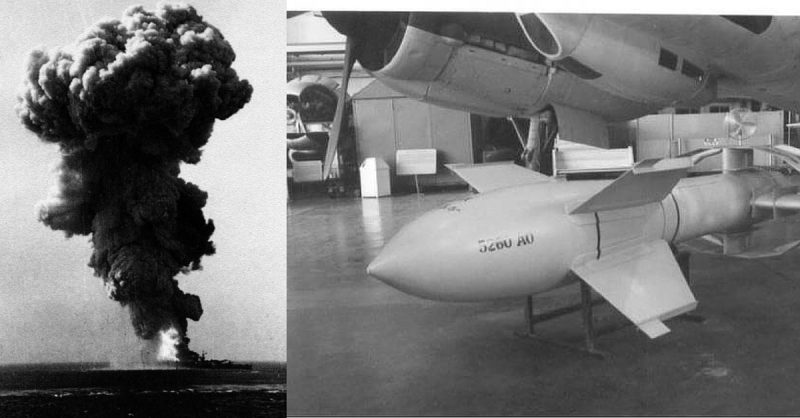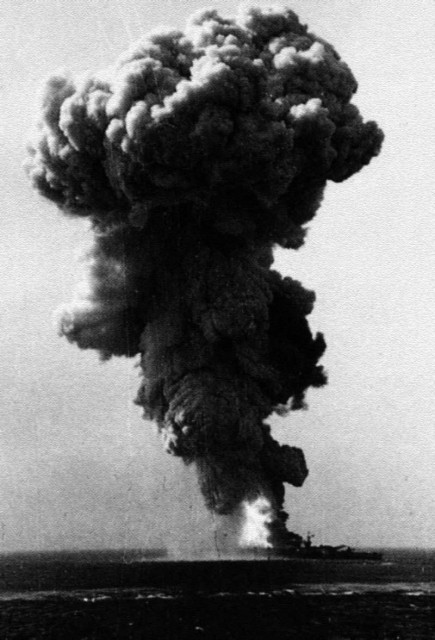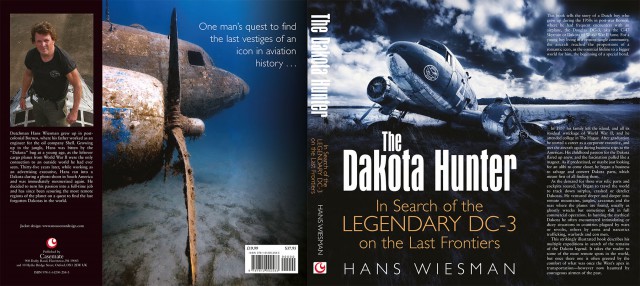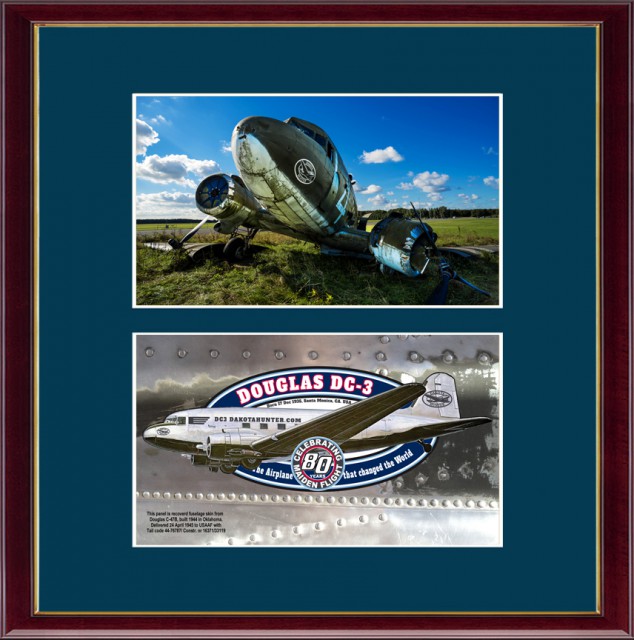The huge explosion and black billowing smoke column give evidence to the incredible success of a secret guided gliding bomb named Fritz X.
Launched 9 Sept. 1943 by a single Luftwaffe Dornier Do-217 Medium Bomber aircraft, it took them only two such bombs to sink the Pride of the Italian Navy, Battle ship Roma and a few more US ships followed as victims of this brand new “Ship Killer”.
First recorded operational use in the history of PGM’s (Precision Guided Munition) was likely with a Guided Gliding Bomb, during the Nazi assault against the Italian Battleship Roma. A true suspense story that is hardly known. The Italian fleet had not had a very active role in the Mediterranean war theater until 1943. Its biggest, most modern battleship Roma (commissioned 1942) was mainly used as AA platform to defend Italian Harbors against Allied air raids.
A couple of months after the Italian up-rise against the Fascist regime and the ensuing arrest of Mussolini, the new Italian PM still supported the German “ally” verbally. But meanwhile, he had secret talks with General Eisenhower over an Italian surrender of troops and Navy. On 8 Sept. 1943, the Italian fleet sailed out from their harbors with a 3 -days delay. The fleet went out under Admiral Carlo Bergamini, officially with the argument to attack the Allied naval forces that had just made an invasion assault on the Italian mainland near Naples, in Salerno (Operation Avalanche, starting 3 Sept. 1943). But in a twist of fate, that same day that the fleet steamed up, Radio Algiers announced the Armistice between the new Italian Government and the Allied forces! That was bad timing for sure, as all Naval ships were still within reach of the Reich’s Luftwaffe!
The whole affair suddenly smelled fishy for the Germans as they realized that the Italian fleet was in reality on its way to a pre-arranged surrender to the Allied Forces in Malta. Germans had no reputation for letting defectors get away with it; they sought revenge for this betrayal, and soon the Italian fleet would find out what the Nazis had developed as a new secret weapon.
A few days after leaving La Spezia in Northern Italy, the fleet was followed at a distance by an aircraft. It was a Dornier Do-217 that remained at a respectable altitude of over 5000 m, clearly staying out of the ship’s AA guns reach. This single aircraft was about to write war history with the launch of a gliding radio controlled bomb that would soon hit Italian’s Naval Pride and sink the Giant Battleship in such simple way as was rarely shown before in the history of Naval Warfare.
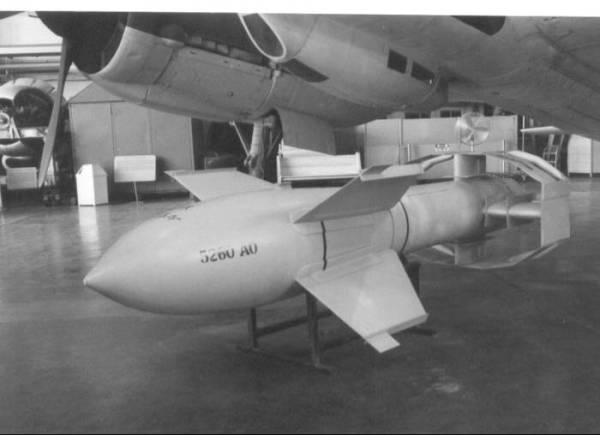
Torpedoes typically came in from U-boats or Dive/ Torpedo Bombers: if they hit the Battleship, it was the explosive charge that made the damage, and it took a great number of hits to knock a large armored Navy ship out (Consider how much effort it cost to sink the Bismark). With Fritz X, a whole new dimension was added to the ball game, named speed.
The 3 tons steel perforating bomb came in with such high speed from 5000 m altitude that it’s energy slammed the bad-ass bomb through 7 decks, and made an exit right under the keel of the ship! As a Captain, you don’t want to have the ensuing explosion right there, far under the water line, but that’s exactly what happened. Hours later, one more such bomb finally had a devastating and lethal effect; that sank the giant Battleship in a matter of hours.
What was the new trick here? Never before, an unmanned bomb could be launched from so far away at high altitude and subsequently hit the target at such speed. The radio controlling of its gliding path gave this bomb its unique combo of long range accuracy and high energy penetrating power at impact.
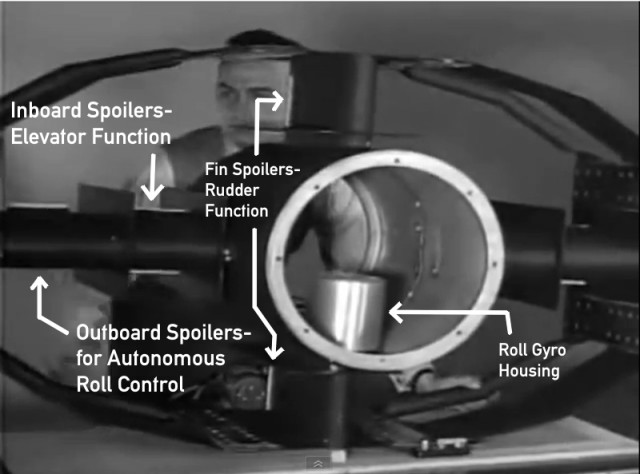
As no one had ever seen such machine before, the Italians saw the launch of this bomb with disbelief as it was far behind them and from a high altitude. They anticipated the normal bomb trajectory of 80 degrees (nearly vertical), so the Admiral must have thought of a poor bomber aiming action or a nervous crew not daring to come any closer because of the ship’s AA guns. But on second sight, the grin of relief on the Admiral’s face must have faded away as this bomb was smoothly gliding and steering toward them. Soon it became very clear that the bomb was homing in and coming after them in a very persistent way. A minute or so later, it turned out also to be a painful and penetrating way!
The first Fritz X launched missed the targeted Italian Navy ship within inches, but the ensuing explosion hit the rudder and slowed the ship as the first sign of worse to come. The next day, Fritz X was back in business, with the giant ROMA as a prime target. After the first hit, that second bomb also penetrated the armored deck like a sheet of cardboard and ended up in the ammo magazines in the lower decks. The explosion was so hefty that the 3-Guns front turret was lifted up and went overboard!
That turret had the size of a large all-steel Bunker and was gone in one single blow…Holy Moley, a new bomb was born. It had just killed the biggest Italian battle ship with only two bombs. The ship went down and out, soon listed and started to sink, taking 1253 sailors to death in its agony, two third of the total crew!
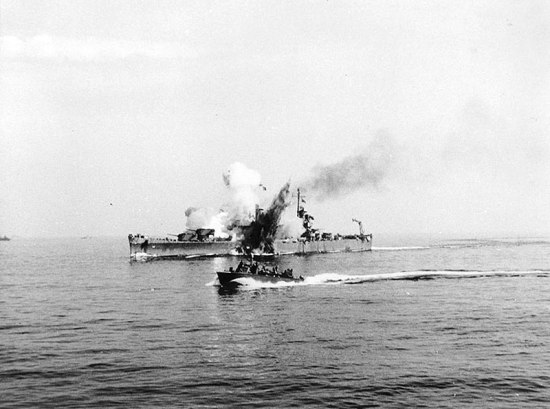
The Germans had another anti-ship gliding bomb in development, the Henschel Hs-293, which came in a variety of versions and soon also was introduced as a rocket engine powered missile. To improve control of the weapon and reduce the vulnerability of the launching aircraft, wire-guided Hs 293B, and television-guided Hs 293D variants were planned. The latter relayed first time in battle history a TV camera frontal view in real time to the operator, seated inside the launching aircraft, but this version never came to full production series.
The Allied forces soon found out about the vulnerability of the “Wunder Bomben.” After they had captured a crashed Heinkel on Corsica and an intact Fritz X bomb in Italy, there surely started a frenzy to investigate the secret machines. The top US scientists went instantly back to the Labs and their Naval Air Ordnance Test Station at Chincoteague Island, Virginia, for probing that German technology of Radio and TV bomb guiding systems.
Their primary interest was with the radio frequencies used on the German transmitters and receivers that directed the bombs. For producing countermeasures, jamming devices were developed that became very effective to defeat the bomb operator’s directional control by taking over the radio command of the Bomb and steering it into the sea. The Jamming Goodies came right in time before the Bombs could eventually be deployed during the Invasions of Normandy (June 1944) and Southern France (Aug. 1944). Both operations with massive shipping involved were already “under construction” and could seriously be hampered by large scale and distant assaults with the high-flying combo “Fritz X and Friends”.
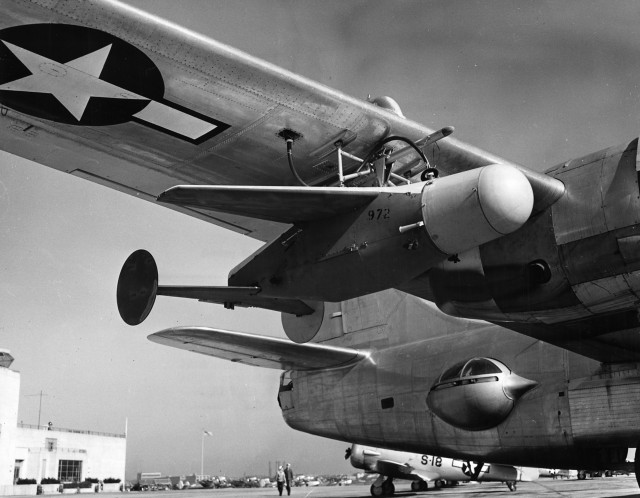
It seems justified to suggest that the German Luftwaffe had a certain advance in the technology of PGM’s during the war years. But it must be said, in January 1941, before the USA entered the war, RCA made a proposal to the US Military with a TV guided anti-shipping bomb. It worked with a TV camera in the nose giving a frontal view to a remote driver/operator in the launching aircraft. The US development of the bomb went on slowly, via the projects Pigeon, Azon, and Pelican. It finally resulted in a new radar homing system from Western Electric, coupled to a 1000-pound General Purpose Bomb.
By end 1944, the production stage started, combining the best of all earlier projects: that was the BAT as seen on the photo above. With a gyro stabilized autopilot supplied by Bendix Aviation and under supervision from MIT (Massachusetts Institute of Technology). The Military had engaged the top of America’s Aviation and Weapons Technology Suppliers. But it was the genius aeronautical scientist Hugh Latimer Dryden(born July 2, 1898, in Pocomoke City, Maryland), Director of NACA who had taken the lead. After the War, he received the President’s Certificate of Merit for his outstanding development works that finally brought the first US made ‘smart’ or guided bomb BAT to an operational level.
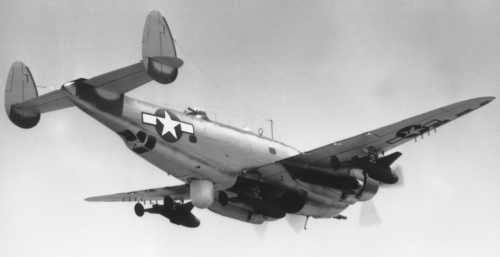
The first Combat experience of the anti-ship variant BAT took place in early April 1945 off the Borneo coast, where PBY4 Y Privateers launched bombs from 15.000 to 25.000 feet. Their targets were Japanese ships that transported oil from the Balikpapan Oil Refinery to the war theaters in the Pacific. Nippon’s Navy and Army operations were seriously hampered by an ever growing lack of fuel. Several Japanese ships were damaged in the attacks, but the bomb also showed a few serious flaws.
Where the Fritz X was still under operator’s guiding control after the bomb’s release, the BAT went on “Automatic Cruise”, no longer controlled by the operator but by the Radar lock. It turned out that both range and accuracy of that automatic tracking system were insufficient. It had difficulty to pick out the exact target in a convoy of more ships and/or with rocks, islands, port installations in the near vicinity. Only after the war, with more testing and maybe a number of “expat” scientists added to the US development team, they overcame the problems and in the end, won the race for the real “Smart Bomb.”
Balikpapan and Tarakan were Japans major oil supply sources, both located at Borneo’s East Coast. That strategic supply line and the refineries were targeted by USAAF Air Raids as from 1944. In June/ July 1945, an Invasion took place on the Balikpapan shores by Australian Forces with USAAF support ( Operation Oboe II). During the air attacks, the huge Oil Storage Tank Park and Refinery were devastated, bringing the total fuel production to a halt.
The Japanese occupational forces became isolated as the war moved on to the Nippon Islands. Many a soldier, instead of surrender, opted for fleeing into the Jungle of Eastern Borneo. It is there that their role as the dominant enforcer with superior weapons suddenly disappeared. Their rifle shots for hunting jungle animals attracted another hunter from miles around. Those were the Dayak tribesmen, skillful head hunters with an official “license to kill” Japanese soldiers, acquired from the pre-war Dutch ruler and USAAF. With that license, they went without any reticence hunting the Japanese soldiers with their blowpipes & venomous darts.
Most of them ended up as a “Shrunken Head” game trophy, dangling on a pole. As the war came to an end in August/ September 1945, many “stragglers” were still out there in that Borneo Jungle. With their guns useless against the invisible, superior human predators, they surely had a little problem to keep their Spooky hunters at bay in that Green Hell. The tribes were not informed by the Allied forces that the war was over, it was the pre-cellphone age, so hard to communicate with Jungle.
And, maybe the good news was bad news for them, so they simply continued their favorite ages-old game: head hunting, fully targeting the straggling Japanese soldiers. And that went on for many more years after 1945, so their numbers reduced slowly but surely. Just a few were lucky and escaped from the tribal hunting grounds, they made it back to the coast, to turn themselves in, totally exhausted and bewildered, and were shipped back to Japan between 1945-1955.
As a young kid, I came in 1950 to Borneo with my father and family. He was a Shell employed oil exploring engineer who had the task to start up the oil production and repairs the war-inflicted damage on installations as oil wells, derricks, pumps and refineries, quite a job on that war devastated Pacific island. I arrived in a dream like Playstation, full of wrecks, bunkers, crashed landing craft, bombed out storage tanks and a stranded Submarine.
Borneo was like a Spielberg movie set; all transports were left behind after the invasion. GMC trucks, Dodge Command cars, Willys Jeeps galore and last but not least, the PBY-5A Catalina and the C-47 Dakota as our airborne friends to move us around on that huge island with no infrastructure. It is there that I was “bitten by the bug” and got a lifetime passion for all war-related transports and tales, in particular for the Douglas C-47/ Dakota, the aircraft that saved my life in 1951.
For more details of that harrowing Dayak Head Hunter story in Borneo (also how they helped downed USAAF crews to survive), fascinating tales about the DC-3/ C-47 and many more global adventures, you should read my book: The Dakota Hunter, in search of the legendary DC-3 on the last Frontiers. (Casemate USA/ UK , ISBN 978-1-61200-258-3)
In 320 pages, you will read most intriguing stories about the last and lost Dakotas of this world, crashed, abandoned or still flying. I truly met so many of them, the 250 photos (most never published before) give evidence of the multiple salvaging expeditions that I made over 20 years to Alaska, the Caribbean, Venezuela, Honduras, Brazil, Thailand, Africa, Madagascar, The Yukon, Bolivia and Colombia, the Amazon region where the DC-3 still flies in “flocks”.
This fully illustrated and engagingly written book (see the book’s jacket below) surely is a most attractive Christmas present, both for a family member, a friend of just for yourself.
You can order the book straight-away, right in time, only a mouse click away if you go to this Amazon link for ordering and reviews of my book.
For more info, a sneak preview, reviews, and chapters of the book, come to my website dc3.dakotahunter.com, where you can also read my previous blogs about the DC-3’s 80 years Maiden Flight Commemorative Plague that I created from recovered C-47 WWII made skin panels, soon for sale (see final photo below).
The photo above is the jacket of my Book The Dakota Hunter.
See www.dc3dakotahunter.com / Follow of Friend me on Facebook here
The photo above depicts the Commemorative Plaque of the DC-3 80 years Maiden Flight that took place 17 Dec. 1935. This Limited Series WW II made the panel is recovered from a C-47 fuselage (dim. 11 x 14 in/ 28 x 36 cm). It is screened with the logo as depicted above and with the photo of the donor C-47 (see in the upper side of the frame, the same size as skin plaque, each 11 x 14 in) will come for sale soon. A Certificate of Authenticity will be supplied with the plaque.
